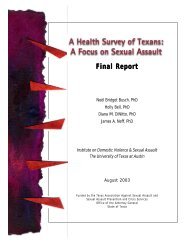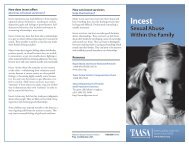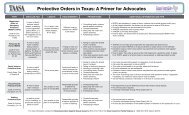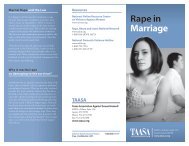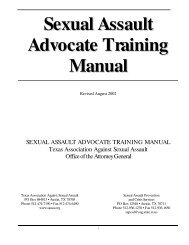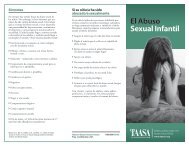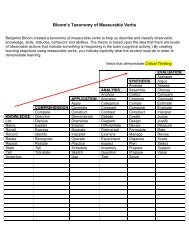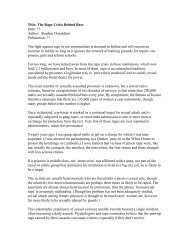Gender effects on individual verdicts and on mock jury verdicts in a ...
Gender effects on individual verdicts and on mock jury verdicts in a ...
Gender effects on individual verdicts and on mock jury verdicts in a ...
You also want an ePaper? Increase the reach of your titles
YUMPU automatically turns print PDFs into web optimized ePapers that Google loves.
After complet<strong>in</strong>g the trial survey, each student was asked to move to a circle of chairs<br />
with others <strong>in</strong> their preassigned (number of females) group, to be a juror. This was not<br />
always the group they had signed up for. For example, <strong>on</strong>ly 8 men may have signed up<br />
for a group of 2 women <strong>and</strong> 10 men. A sec<strong>on</strong>d group <strong>on</strong> the same day, at the same time,<br />
was 8 women <strong>and</strong> 4 men, <strong>and</strong> a third group was 4 women <strong>and</strong> 8 men. If a total of 17 men<br />
<strong>and</strong> 13 women showed up, we ran two real groups as best we could, e.g., 2 women <strong>and</strong> 9<br />
men <strong>and</strong> 4 women <strong>and</strong> 8 men. The rema<strong>in</strong><strong>in</strong>g 7 women sat as a <strong>jury</strong>, but were not counted<br />
as a <strong>jury</strong>. (The smallest sized <strong>jury</strong> counted was 10, e.g., 10 men). The first pers<strong>on</strong> to<br />
f<strong>in</strong>ish <strong>in</strong> each group was asked by the experimenter to be the forepers<strong>on</strong> <strong>on</strong> the <strong>jury</strong>. (This<br />
was d<strong>on</strong>e to save time <strong>and</strong> to maximize the time available to jurors to try to reach a<br />
verdict). They were told this would <strong>in</strong>volve their tell<strong>in</strong>g the group that they would have to<br />
try to reach a unanimous verdict, like a <strong>jury</strong>. First, the forepers<strong>on</strong> would ask every<strong>on</strong>e to<br />
write their verdict <strong>on</strong> a piece of paper, fold it <strong>and</strong> pass it to her/him. If not unanimous,<br />
then the forepers<strong>on</strong> was asked to announce the vote, <strong>and</strong> then lead a discussi<strong>on</strong><br />
prelim<strong>in</strong>ary to a sec<strong>on</strong>d ballot <strong>and</strong>, if necessary, a third. The forepers<strong>on</strong> was given a copy<br />
of the trial <strong>and</strong> told to c<strong>on</strong>sult it if jurors couldn't recall, recalled <strong>in</strong>correctly or disagreed<br />
about facts <strong>in</strong> the case.<br />
If, after three ballots, there was no unanimous verdict, <strong>and</strong> there was no change from the<br />
sec<strong>on</strong>d to third ballots, then the experimenter asked the jurors if any<strong>on</strong>e vot<strong>in</strong>g "guilty"<br />
would, no matter how l<strong>on</strong>g the <strong>jury</strong> took, never change their vote; <strong>and</strong> the same was<br />
asked of those vot<strong>in</strong>g "not guilty." If at least <strong>on</strong>e pers<strong>on</strong> <strong>in</strong> each category <strong>in</strong>dicated they<br />
would never change their vote, the <strong>jury</strong> was judged to be hung. Otherwise, they were<br />
asked to engage <strong>in</strong> another discussi<strong>on</strong> <strong>and</strong> vote, which was the last vote. When the verdict<br />
either was unanimous or hung, then written feedback as to the purpose of the experiment<br />
was passed around to be read <strong>and</strong> discussed.<br />
RESULTS<br />
<str<strong>on</strong>g>Gender</str<strong>on</strong>g><br />
Based <strong>on</strong> the f<strong>in</strong>d<strong>in</strong>g that more females than males vote guilty <strong>in</strong> simulated rape trials<br />
(Fischer, 1991), it was hypothesized that the number of guilty <strong>verdicts</strong> would <strong>in</strong>crease as<br />
a functi<strong>on</strong> of the number of women <strong>on</strong> the <strong>jury</strong>, at least <strong>on</strong>ce women were a majority. As<br />
a first test of this hypothesis, the expected gender effect <strong>on</strong> <strong><strong>in</strong>dividual</strong> <strong>verdicts</strong> was<br />
assessed. This was d<strong>on</strong>e us<strong>in</strong>g a logistic regressi<strong>on</strong> of five demographic variables<br />
(gender, marital status, ethnicity, age, <strong>and</strong> number of sibl<strong>in</strong>gs) <strong>and</strong> their sec<strong>on</strong>d order<br />
<strong>in</strong>teracti<strong>on</strong>s <strong>on</strong> guilty <strong>verdicts</strong>. This model classified <strong>on</strong>ly 66.8% of <strong>verdicts</strong> correctly,<br />
with gender <strong>and</strong> the gender by sibl<strong>in</strong>gs <strong>in</strong>teracti<strong>on</strong> the <strong>on</strong>ly statistically significant <str<strong>on</strong>g>effects</str<strong>on</strong>g><br />
(logl = 3.15, SE = 1.45, p [less than] .05; logl = 0.34, SE = 0.06; p [less than] .05,<br />
respectively). As expected, more women than men voted guilty, i.e., 86% of the 426<br />
females versus 66% of the 398 males. Also, males (but not females) from smaller families<br />
(e.g., 2 or fewer sibl<strong>in</strong>gs) were somewhat more likely to vote guilty than males from<br />
larger families.<br />
Table I summarizes data relat<strong>in</strong>g to the hypothesis that the number of guilty <strong>verdicts</strong>



